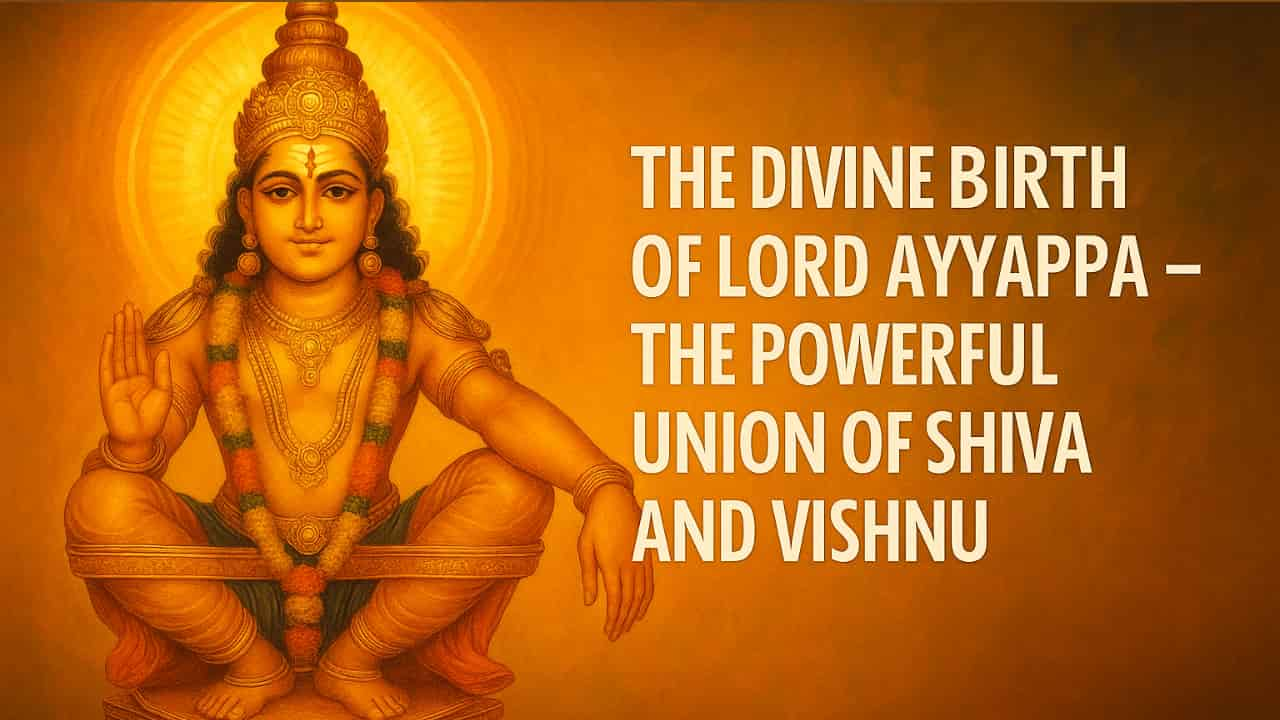
Table of Contents
President's Historic Visit to Sabarimala
In a remarkable and spiritually significant moment, the President of India, Droupadi Murmu, visited the Sabarimala Temple in Kerala on October 22, 2025, to offer prayers to Lord Ayyappa.
Her visit marked a historic occasion, as she became the first woman head of state to enter the sacred shrine and ascend the revered Pathinettam Padi, the eighteen divine steps leading to the sanctum. The President’s gesture was seen as a tribute to Lord Ayyappa’s message of devotion, equality, and dharma, drawing attention once again to the enduring legacy of the deity born from the divine union of Lord Shiva and Lord Vishnu’s Mohini avatar.
The temple authorities and devotees welcomed the event as a moment of national reverence, highlighting the timeless spiritual influence of Lord Ayyappa across India.
A Child of Divine Balance
In the sacred hills of Sabarimala, pilgrims walk barefoot through forests, chanting the name of a god born of paradox. Lord Ayyappa, the warrior deity, is the son of Shiva and Vishnu, born not of tradition, but of divine necessity.
His birth is a union of masculine energies, a symbol of cosmic balance, and a tale of dharma triumphing over chaos. His story is not just about defeating evil; it is about embodying harmony, celibacy, and spiritual discipline in a world of distraction.
The Divine Union
The story begins with the demoness Mahishi, born of a boon that made her invincible to all except a child born of Shiva and Vishnu. To fulfill this condition, Vishnu took the form of Mohini, the enchantress, and united with Shiva. From this union came Lord Ayyappa, Hariharaputra, the son of Hari (Vishnu) and Hara (Shiva).
This birth was not ordinary. It was a divine solution to a cosmic imbalance. Ayyappa was born with purpose, clarity, and strength. His existence itself was a message that divine forces can transcend form and gender to restore dharma. The union of Shiva and Vishnu, mediated by Mohini, is a rare moment in mythology where boundaries dissolve, and creation arises from unity rather than division.
Mohini’s role is especially significant. She is not merely a form of Vishnu but a divine feminine force who catalyzes creation. Her presence in the story reminds us that the feminine is not passive; it is transformative, active, and essential to cosmic balance.
The union of Shiva and Mohini is not a contradiction; it is a revelation. It shows that divinity is fluid and that the sacred can take any form to fulfill dharma.
Childhood in the Forest
Lord Ayyappa was found as a baby near the river Pampa by King Rajashekhara of Pandalam, who raised him as his own. Though royal by upbringing, Ayyappa chose the forest as his teacher. He grew in silence, strength, and spiritual discipline. His eyes held wisdom beyond years, and his heart beat with the rhythm of dharma.
He healed the sick, protected the weak, and taught by example. Yet his destiny awaited. He was not just a prince, he was a yogi, a warrior, and a guide. His childhood was marked by acts of compassion and clarity, and even as a boy, he radiated the serenity of a sage.
The forest shaped him. It was not a place of exile, but of awakening. In its silence, he learned to listen. In its wildness, he learned restraint. In its solitude, he found the divine. The river Pampa, the trees, the animals, all became his companions in spiritual growth. He did not seek the throne, he sought truth.
The Battle with Mahishi
Mahishi, the buffalo demoness, wreaked havoc across realms. Her arrogance was born of invincibility, her rage fueled by imbalance. Lord Ayyappa, now a young warrior, confronted her. Their battle was fierce, symbolic of the clash between ego and dharma.
With grace and power, Ayyappa defeated her, not with rage, but with righteousness. His victory was not just over a demon, it was over imbalance, ignorance, and arrogance. The battle marked the fulfillment of his divine purpose and the beginning of his spiritual legacy.
But the battle was not merely physical. It was a cosmic drama where the forces of chaos were subdued not by brute strength, but by inner clarity. Ayyappa’s calm in the face of fury, his restraint in the face of provocation, made him not just a victor, but a teacher.
Mahishi’s defeat was not an act of vengeance; it was an act of restoration. Lord Ayyappa did not destroy her out of hatred; he liberated her from the burden of her boon. In doing so, he restored balance to the cosmos and reminded all beings that dharma is not about domination; it is about alignment.
The Celibate Pilgrim God

After the battle, Lord Ayyappa renounced royal life and chose the path of celibacy and meditation. He retreated to the hills of Sabarimala, where he became the deity of pilgrims. Devotees now follow his path, observing austerity, wearing black, and walking in brotherhood.
His vow of celibacy is not rejection; it is transcendence. It reflects detachment, discipline, and devotion. The pilgrimage to Sabarimala is not just physical; it is a journey inward, a purification of mind and soul.
The 41-day vratham observed by devotees before the pilgrimage is a spiritual preparation. It involves abstaining from worldly pleasures, practicing humility, and cultivating inner silence. In this discipline, Lord Ayyappa’s essence is invoked, not as a distant god, but as a living presence guiding each step.
The climb to Sabarimala is symbolic. It is not just a trek through terrain; it is a metaphor for the ascent of the soul. Each step is a shedding of ego, each chant a call to the divine.
The forest becomes a temple, the path a prayer.
Symbolism and Legacy
Ayyappa’s story carries deep symbolism:
- Union of Shiva and Vishnu: harmony between destruction and preservation
- Mohini’s role: the divine feminine as catalyst and creator
- Mahishi’s defeat: dharma overcoming ego
- Sabarimala pilgrimage: a journey of inner purification
- Celibacy as strength: not denial, but spiritual focus
- Brotherhood among pilgrims: equality and unity in devotion
The pilgrimage to Sabarimala is one of the few spiritual journeys where caste, creed, and class dissolve. All pilgrims are addressed as “Swami,” reflecting the belief that every seeker is divine. In the forest, under the stars, walking barefoot, they become one, united in devotion, discipline, and the pursuit of truth.
Ayyappa’s legacy is not confined to temples. It lives in the hearts of those who walk his path. It lives in the silence of discipline, the strength of restraint, and the unity of brotherhood. He is a god who does not demand offerings; he demands transformation.
His story also speaks to modern seekers. In a world of distraction, Lord Ayyappa offers clarity. In a world of division, he offers unity. In a world of indulgence, he offers restraint.
He is not just a deity of the past; he is a guide for the present.
Lord Ayyappa: The Warrior of Dharma
Lord Ayyappa is not just a god of war; he is a god of balance. His birth, life, and legacy teach that dharma is not rigid; it is compassionate, inclusive, and powerful. In every pilgrim’s chant, in every forest path walked in silence, Ayyappa lives.
He is the child of paradox, the warrior of peace, and the guardian of truth. His story reminds us that true strength lies in restraint, and true divinity in harmony. In the union of Shiva and Vishnu, in the tears of Mohini, in the silence of the forest, and in the chants of pilgrims, Lord Ayyappa walks with us, guiding us toward the light.
He is the god who was born to restore balance, who chose solitude over power, and who turned pilgrimage into a path of transformation. In every step taken toward Sabarimala, in every vow kept, in every moment of silence, Lord Ayyappa is present.
He is not just remembered, he is lived.

